30 incredible treasures discovered in King Tut's tomb
When archaeologist Howard Carter and colleagues discovered King Tut's tomb 100 years ago, he reported seeing "wonderful things." Here are 30 lavish findings from the ancient Egyptian burial.
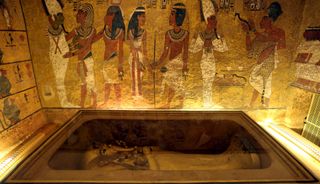
- 1. Death mask
- 2. Iron daggers
- 3. Board games
- 4. Garment mannequin
- 5. Golden sandals
- 6. Tutankhamun's coffin
- 7. Tutankhamun's throne
- 8. Chariots
- 9. Trumpets
- 10. Anubis
- 11. Breastplate
- 12. Osiris wall painting in tomb
- 13.Ivory-covered box
- 14. Anubis and Hathor wall painting
- 15. Animal Mural
- 16. Canopic Jars
- 17. Tut and wife
- 18. Cup
- 19. Jar
- 20. Shabti
- 21. Bed
- 22. Diadem
- 23. Mummy
- 24. Hippo Hunter
- 25. Model Boat
- 26. Outside box
- 27. More Shabtis
- 28. Wooden box
- 29. Gold buckle
- 30. Headrest
Tutankhamun's tomb, discovered by archaeologists in the Valley of the Kings on Nov. 4, 1922, was found loaded with treasures. Some of those artifacts, like his death mask, are widely known. But others, such as a mannequin that may have helped the boy king choose what to wear, are less famous but offer insight into King Tut's life. Here are 30 fascinating treasures from Tutankhamun's tomb and what they reveal about the iconic ancient Egyptian pharaoh 100 years after the discovery of his remains.
1. Death mask

Tutankhamun's death mask is probably the most famous artifact found in his tomb. Placed on Tut's face, the 21-inch-long (53 centimeters) ornate mask was manufactured mainly from gold inlaid with semiprecious stones and coloured glass paste" and weighs a whopping 22 pounds (10 kilograms), Galal Ali Hassaan, an emeritus professor in the Cairo University Department of Mechanical Design, wrote in a 2016 paper published in the International Journal of Advancement in Engineering & Technology. "The eyes are produced from obsidian and quartz," Hassaan wrote, noting that the mask depicts Tutankhamun with a long beard and a headdress bearing a cobra and a vulture.
On the back of the death mask is a spell from the Book of the Dead, written in hieroglyphs, which "guaranteed the mask's ability to function as the face of the deceased," Marianne Eaton-Krauss, a senior fellow at the American Research Center in Egypt, wrote in her book "The Unknown Tutankhamun" (Bloomsbury, 2016). She noted that the third innermost coffin that Tutankhamun was buried in has the same spell written on it.
2. Iron daggers
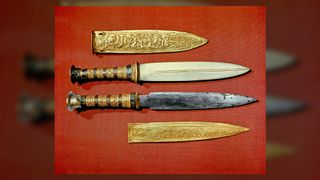
Tutankhamun was buried with two daggers — one with an iron blade and one with a gold one. Both daggers were found wrapped in different layers of the pharaoh's mummy bandages, according to the book "Iron from Tutankhamun's Tomb" (American University in Cairo Press, 2022).
The dagger with the iron blade was placed by Tutankhamun's right thigh, researchers noted in the book. The iron used in the dagger was out of this world, crafted from a meteorite, and the dagger has a pommel made of rock crystal as well as a gold handle with intricate patterns carved on it. The dagger with the gold blade, which also has a gold handle with intricate carvings, was found above the abdomen of Tutankhamun, the researchers wrote.
Both daggers show signs of wear, Katja Broschat, a conservator at the Römisch-Germanisches Zentralmuseum and co-author of "Iron from Tutankhamun's Tomb," wrote in an email to Live Science. Broschat said it is not certain whether either dagger was ever used in a hunt or some other activity.
3. Board games
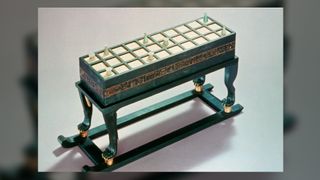
Tutankhamun's tomb had at least four board games in it, according to the book "Ancient Egyptians at Play: Board Games Across Borders" (Bloomsbury, 2016). Some of the boards and game pieces found in the tomb were made of ivory, and the boards seem designed for the "game of twenty" and "senet."
Sign up for the Live Science daily newsletter now
Get the world’s most fascinating discoveries delivered straight to your inbox.
Neither game's rules are entirely clear. The Grand Egyptian Museum notes that senet was played with a board of 30 squares and the goal "was to safely navigate all the pieces off the board while preventing the opponent from doing the same."
The "game of twenty" rules are also uncertain. Among scholars who have studied the game, "it is generally assumed that the two players started on each of the opposite sides of the board" and that "they then moved their pieces down the central aisle toward the final field and off the board to win the game," Anne Dunn-Vaturi, a research associate at the Metropolitan Museum of Art, wrote in an article published on the Metropolitan Museum of Art's website in 2014.
4. Garment mannequin

One of the lesser-known treasures from Tutankhamun's tomb is a mannequin used to help choose, adjust and store the king's wardrobe and jewelry. "Tut was, of course, a very snappy dresser with a huge wardrobe, both for his life and afterlife," Laura Ranieri Roy, founder and director of Ancient Egypt Alive, an educational organization, told Live Science in an email.
"There were hundreds of garments — 12 sumptuous robes, dozens of sandals, underwear, socks, even Tut's baby clothes" that British archaeologist Howard Carter found in Tut's tomb, Ranieri Roy noted. "It makes sense for such a 'clothes horse' to need a mannequin on which to hang, display ornate robes and jewelry, even perhaps for his wardrobe attendants to make and prepare outfits and make adjustments to the king's vestments."
5. Golden sandals
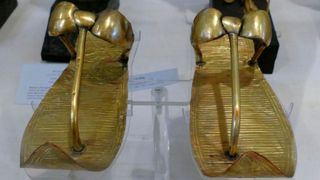
Tutankhamun's mummy was found wearing gold sandals. "The total length was about 29.5 cm [11.6 inches]," Andre Veldmeijer, director of the Ancient Egyptian Footwear Project, told Live Science in an email. Tutankhamun likely would not have worn these sandals when he was alive, Veldmeijer said. Sandals like these would likely have been made specifically for his burial.
These gold sandals would have been "cut from a plate of gold sheet and embossed, probably on a soft surface protected by a layer of leather," Veldmeijer said, noting that this process is "not that different from how in modern days thin metal is hammered into shape and decorated."
6. Tutankhamun's coffin
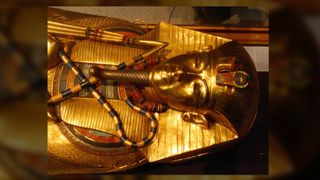
Tutankhamun was laid to rest within three coffins nested within each other. The combined coffin weighs about 1.25 tons (1.3 metric tons), Joyce Tyldesley, an Egyptology professor at the University of Manchester in the U.K., wrote in her book "Tutankhamen: The Search for an Egyptian King" (Basic Books, 2012). The large size of the coffins, coupled with the relatively small size of Tutankhamun's tomb, made it challenging for Carter to open them, Tyldesley noted.
All three coffins show Tutankhamun with a long beard and holding a crook and flail. The Egyptian Ministry of Tourism and Antiquities notes that the outer coffin is made of gilded wood and has blue and red glass on its crook and flail. Tyldesley said the second coffin is also made of gilded wood and was found with several plants — including disintegrating lotus flowers — on it. The ministry notes that the third and innermost coffin is made of solid gold and was found wrapped in linen. Tutankhamun was laid to rest within this innermost coffin, with his death mask among other items on him.
7. Tutankhamun's throne
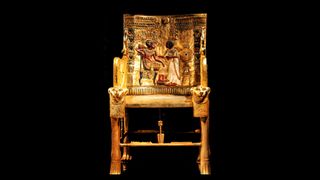
Two thrones were found in Tutankhamun's tomb, Eaton-Krauss said. One was made of ebony, and because it resembled a bishop's chair, Carter called it the "ecclesiastical throne," although there is no evidence that it had a special religious purpose.
The other throne, sometimes called the "golden throne," has a depiction of Tutankhamun and his wife, Ankhesenamun, Tyldesley noted in her book. In his notes, Carter wrote that Ankhesenamun seems to be placing ointment or perfume on Tutankhamun.
This throne is about 3 feet (1 meter) tall and was wrapped in linen. It "is a wooden chair with a solid, slightly sloping back panel, arms, openwork side panels and four legs carved to resemble lion legs" Tyldesley wrote. "The chair was covered in gold and silver foil and inlaid with colorful stones, glass and faience [glazed ceramic]."
"As most ancient Egyptians squatted on the floor, or sat on low stools, chairs were a luxury item, indicative not only of wealth, but also of power," Tyldesley wrote.
8. Chariots
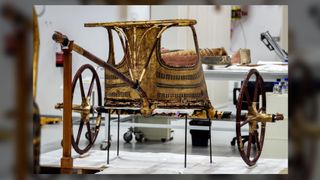
Six chariots were found in Tutankhamun's tomb, according to research published in 2020 in the journal Comité international pour l'égyptologie (French for "International Committee for Egyptology.") Carter referred to two of the most elaborate chariots as "state chariots," the team noted in their paper. The researchers' in-depth analysis and restoration of one of the state chariots found that it had a canopy above it that could have provided shade for those riding in it.
The chariot also has images of six foreign captives on its right side, as well as hieroglyphs with the names of Tutankhamun and Ankhesenamun. It also has an image of a solar falcon with outstretched wings and a hieroglyphic inscription saying that the falcon represents Horus, an Egyptian god associated with the sun.
"This entire design may be interpreted as the appearance of the royal couple adored by the people of Egypt, ensuring the life and stability of the king and queen under the sun god who is hovering above and protecting them," the team wrote in their paper.
9. Trumpets

Two trumpets — one made of silver and the other of gilded bronze — were found in Tutankhamun's tomb and are among the oldest surviving labrosones, instruments played with vibrations from the lips, in the world, according to the book "The Science of Brass Instruments" (Springer International Publishing, 2021).
Musician James Tappern played the trumpets in a 1939 BBC broadcast that can be heard on YouTube. However, to play the trumpets, he had to use a modern wooden mouthpiece, so it's not clear if the pitches Tappern played would have been possible in Tutankhamun's time, the researchers noted. Today, the playing of these instruments is prohibited because of their fragility.
10. Anubis

This statue of Anubis, a jackal-headed ancient Egyptian god associated with mummification, was found in Tutankhamun's tomb. It is made of wood and gold.
11. Breastplate

This colorful breastplate was discovered in the tomb of Tutankhamun and appears to have a scarab-shaped amulet at center. These amulets were often found in ancient Egypt, as the scarab beetle was seen as a symbol of resurrection or rebirth.
12. Osiris wall painting in tomb
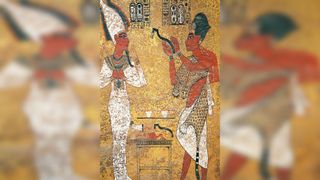
This wall painting in Tutankhamun's tomb shows the pharaoh interacting with Osiris, a deity considered to be god of the underworld. Tut was about 19 years old when he passed away.
13. Ivory-covered box
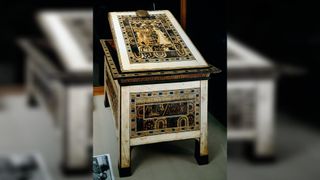
This wooden box, covered with ivory, is from the tomb of Tutankhamun. The box has elaborate paintings on it that display motifs which are difficult to interpret.
14. Anubis and Hathor wall painting
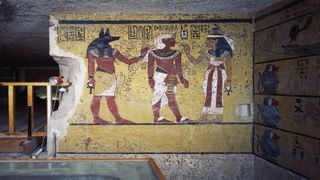
In this wall painting, Tutankhamun is flanked by the ancient Egyptian deities Anubis and Hathor. Anubis is a jackal-headed god associated with mummification, while Hathor is associated with fertility and love, among other things.
15. Animal Mural
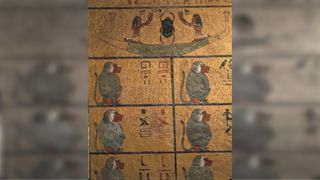
This mural from Tutankhamun's tomb appears to show six baboons, as well as a scarab on a boat. Baboons were imported to Egypt from further south, while scarab beetles were associated with rebirth or resurrection.
16. Canopic Jars
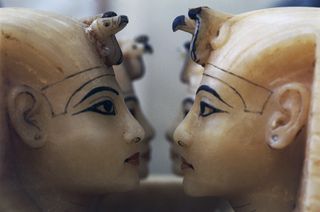
The lid of canopic jars found in Tutankhamun's tomb. Jars like these held the remains of internal organs — such as the liver and lungs — that were removed during the mummification process.
17. Tut and wife

Tutankhamun and his wife, Ankhesenamun, are shown in this painting found in Tut's tomb. The tomb of Ankhesenamun has not been found and is believed to be somewhere in the Valley of the Kings.
18. Cup
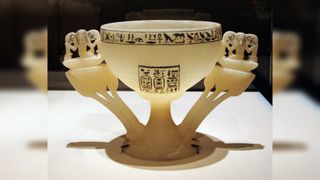
This floral-shaped cup is from Tutankhamun's tomb. The hieroglyphic inscriptions on it ask that Tut be given millions of years of life.
19. Jar
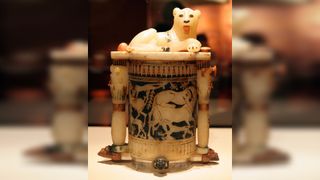
This jar, found in Tutankhamun's tomb, has a lion at top. The motifs at the bottom may represent Egypt's enemies in Nubia and western Asia and may represent triumph over them. The jar may have been used to hold cosmetics.
20. Shabti
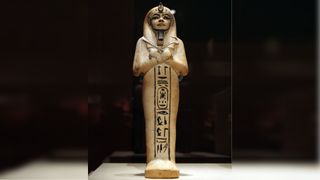
A shabti found in Tutankhamun's tomb. Shabtis are commonly found in ancient Egyptian tombs and were meant to serve the deceased in the afterlife. This shabti is made of limestone and is holding a crook and flail.
21. Bed
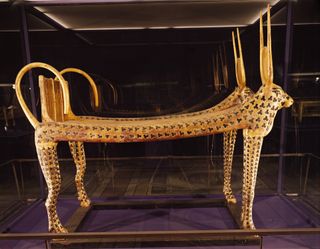
This bed is one of several found in the tomb of Tutankhamun. Made of wood gilded with gold, it has depictions of cows on it. In ancient Egypt, cows were sometimes associated with Hathor, a goddess associated with fertility and love.
22. Diadem
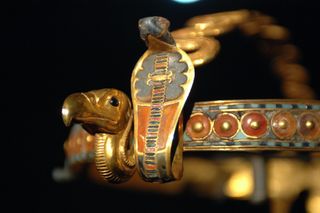
This diadem, found in Tutankhamun's tomb, has depictions of a vulture and cobra on it. It is made of gold along with glass, lapis lazuli, obsidian and malachite, among other materials.
23. Mummy

Tutankhamun's mummy still rests in his tomb in the Valley of the Kings. While many of the objects in his tomb have been moved into museums, the pharaoh remains in his tomb.
24. Hippo Hunter

This small statue, found in Tutankhamun's tomb, shows the pharaoh hunting hippos with a harpoon. Despite his health problems, it's possible that Tut went hippo hunting in real life.
25. Model Boat
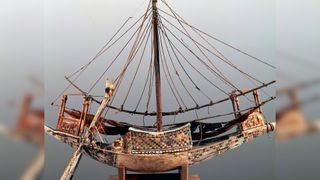
A model of a boat, found in the tomb of Tutankhamun. Made of painted wood with sail rigging, the model is about 3.9 inches (10 cm) across and 8.7 inches (22 centimeters) long.
26. Outside box

The three coffins of Tutankhamun were found in a quartzite box, shown here. It has depictions of four goddesses inscribed on it: Isis, Nephthys, Neith and Selket.
27. More Shabtis
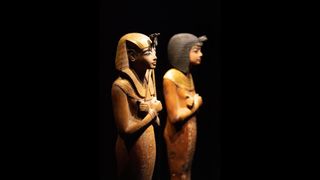
Additional shabtis found in Tutankhamun's tomb. One of them has a headdress known as a "Nemes Headdress," and the other has a wig known as a Nubian wig.
28. Wooden box
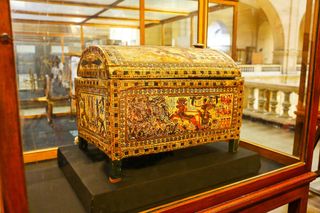
A painted wooden box that was found in Tutankhamun's tomb. It has depictions of hunting scenes on it.
29. Gold buckle

This golden buckle was found in Tutankhamun's tomb. It has a depiction of the pharaoh riding on his chariot.
30. Headrest
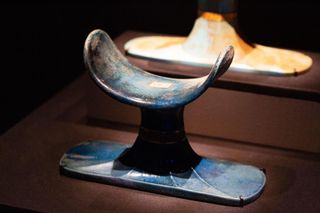
This headrest, made of blue faience (glazed ceramic), was found in the tomb of Tutankhamun. It could be used a bit like a pillow.

Owen Jarus is a regular contributor to Live Science who writes about archaeology and humans' past. He has also written for The Independent (UK), The Canadian Press (CP) and The Associated Press (AP), among others. Owen has a bachelor of arts degree from the University of Toronto and a journalism degree from Ryerson University.
